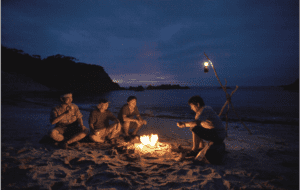By Merisa Sherman
Immediately upon arriving at the campsite, we split up into two teams. The teams are never the same, but the tasks always are. The tent has to be set up in a safe place away from possible falling trees and in such a way that water won’t drain under the tent during the night. The bottom of the tent is called a bathtub base, since the sides go up a little bit, but trust me, you do not want to wakeup at 2 a.m. during a rainstorm because it feels like you are floating. Been there. Everything was dry inside the tent, but it was definitely a creepy feeling.
Anyway, rain was probably not going to be an issue this particular evening, but the wind might be so it was extremely important to look around for weak or aging trees. Luckily for us, we found a great spot to set up the tent in a safe place without the possibility of roots or rocks digging into us during the night. I was at a site once where the only safe spot was with a root sticking into my air mattress — didn’t get too much sleep that night.

The second task is to get the fire started for dinner. If we’re traveling fast and light or in a more backcountry area, that involves getting out the camp stove, pumping and priming. Not a very difficult task but one that certainly makes the difference.
I forgot the gas bottle at home once and cold dinner did not go over very well at all. It was … depressing and we were both super glad that it was only a one night trip. But I can promise you that I have never forgotten the gas bottle again!
But this night, we were canoe camping at a campsite. Not one of those fancy, pay at the entrance and issued a number campsites but one where you paddle around and find a pile of rocks designating a fire pit campsites. I love all campsites in the woods, but these kind are my favorite. There’s no picnic table or little outhouse structure anywhere. Just a bunch of rocks in a pile to mark the fire pit.
Campers talk so much about the construction of the fire, shall we make a teepee or a log cabin? Do you hunt around for birch paper or do you bring a little fire starter kit? Are you a twiggy fire kind of person, or do you sit there with your lightweight camping axe and chop away to make kindling? Whatever your system, it is engrained from childhood, passed down on your first camping trip from your parents and their parents before them.
But fires come and go. What stays is the rocks laid out to protect the flame, some formation that is constantly changing but still always there. We have camped at the same campsite for years, and every time we go, the fire pit is different. Rocks have been moved to make the back wall higher or thicker to block it from the wind. Or maybe a side has been further constructed to block the fire from a swirling wind. Perhaps someone wanted a better cooking space, and so they pulled the front end down a bit or they brought children and made the walls higher for their protection.
And then I wonder how long this pile of rocks has been here. This particular fire pit that I’m currently staring into is on Chittenden Reservoir and I cannot help but wonder if it’s been here since the res was constructed by CVPS in 1909 or if this is a relatively recent one, built after the land was sold to the Green Mountain National Forest around 2001. Either way, it’s a collection of rocks that has developed over the course of decades and I always wonder who was here before me.
We have built something together, we and the people with whom we have shared this campsite over the years. We have protected the basic human development of fire together. According to scientists, homo sapiens have been building fire pits for millions of years. Since we were originally hunter gatherers, does that make fire pits the earliest sign of communication and connection between homo sapiens of different groups? Were prehistoric cowboys sitting around a campfire, moving rocks around to protect the flame as they traveled through?
As I stare into the fire, I’m struck by the engineering of it all. How many different humans have worked on this firepit, making it into the sculpture it is today? A group art project, where no one who helped develop the project might ever meet but here we are creating something together that has changed the fate of humanity. And here I thought we were simply roasting marshmallows.




